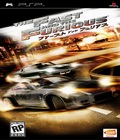Genre: Racing
Publisher: Namco Bandai
Developer: Eutechnyx
Release Date: April 24, 2007
When told that I would have the opportunity to speak with the producer of The Fast and the Furious, the first question that popped in my mind was pretty obvious: "Why not call the third film, '3 Fast 3 Furious?'" Sure, it's absurd and may not make any sense, but such things rarely matter in the world of mainstream Hollywood.
But when the dust settled, it turned out I would be talking to the producer of The Fast and the Furious game, not the epic film trilogy. Oh well. I'll get that question answered eventually. So anyway, I found myself on the phone with Mitch Boyer, associate producer over at Namco Bandai, and Mitch had some interesting things of his own to say about The Fast and the Furious.
"Licensed games are sort of a blessing and a curse," he says, further explaining his frustration with the mediocre critical reaction to the PlayStation 2 version of the game, which shipped in September. Boyer believes that many reviewers failed to give it "a fair shake," and that the license may have created preconceived notions in the minds of journalists everywhere. (We did not review the game, though MetaCritic attributes an average of just 61 to it.)
Despite its critical drubbing, Boyer takes solace in the "overwhelmingly positive" reactions he and his team found while checking out message boards over the last few months. Despite the seven-month gap between the release of the PS2 version and the forthcoming PSP iteration, The Fast and the Furious has not been lost to the sands of time. In fact, the PSP version packs everything from its console brethren and more – including Ad Hoc multiplayer modes and behind-the-scenes content from the film series.
According to Boyer, the additional time was used "to maintain what [they] had in the PS2 version and make sure all of that came over intact," from the visuals to the amount of total content. "The PSP hardware is pretty competent, but it's not a PS2," he added, noting that extensive work was put into the development of the PSP version to maintain the visual quality of the original version. All of the visual effects made the transition, resulting in an experience that, while not visually identical, should compare rather favorably to the console release.
Though the PSP offers analog control, the miniature nub is hardly comparable to the analog sticks found on most console controllers. As such, racing games on the handheld tend to control very loosely, and most would agree it's much more of a hardware gaffe than a programming issue. "You've got a bit of a steeper learning curve," Boyer admitted, referring to the difficulties of bringing a console racing game to the handheld. "You lose a lot of the finesse that you have on the Dual Shock [2]." However, Boyer stressed that the PSP control scheme would maintain the same feel as that of the PS2, despite the learning curve.
Bringing The Fast and the Furious to the PSP wasn't just about maintaining the console experience, but rather enhancing it in hopes of attracting a wider audience. This is largely represented by the addition of two Ad Hoc multiplayer modes: Tag Battle and Swap Meet. Tag Battle takes inspiration from a scene in "2 Fast 2 Furious," a film referred to (sarcastically) as a "cinematic triumph" by Boyer. Two-vehicle teams each send their first racer from one end of the track to the other, at which point the initial racer pulls a U-turn and heads back to the start. The second driver is then tasked with repeating the action and making it back before the other guy does.
"Tag" also refers to an action that brings to mind the Graffiti multiplayer mode from the Tony Hawk games, in which you "tag" part of the environment by scoring the most points on it. In The Fast and the Furious, each winding mountain path has several curves that you must drift through, and the driver with the most fantastic drift maneuver tags that turn as his own. The team with the most tags at the bottom of the hill wins the event.
Every time you link up via Ad Hoc with another player, you will be given the opportunity to view his/her cars. If you see something you like, you can request to have a copy sent to you via the Swap Meet feature of the game. Have a friend who likes to tinker with the visual appeal of his vehicles? "One of the things that we've added to the PSP is a full vinyl swap," said Boyer. When sent a vinyl layout by a buddy, you can assign it to any vehicle in your possession, even if it differs from the one on which the stickers were initially applied.
All of the bits and pieces of the console experience have made the transition to the PSP, from the complete licensed soundtrack of hip-hop and electronica to the 100 officially licensed vehicles from around the world. Though the game is not based directly on "The Fast and the Furious: Tokyo Drift," additional assets from the film have been added. Sean Boswell's 1967 Ford Mustang (with the engine of a Nissan Silvia) is an exclusive addition to the PSP version, and behind-the-scenes content from Universal Studios should shed additional light on the film — and perhaps its transition into a game.
The Fast and the Furious for the PSP looks to be very similar to its PlayStation 2 predecessor in terms of content and presentation, though it remains to be seen if the additional multiplayer capabilities will be enough to draw in gamers scared off by the license or the poor review scores of the initial release. The Fast and the Furious is currently slated to hit stores in late April with an MSRP of $29.99.
More articles about The Fast And The Furious




























